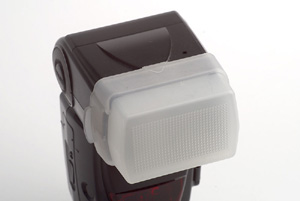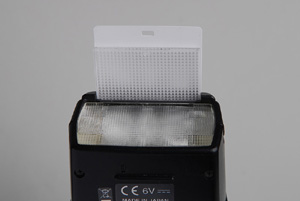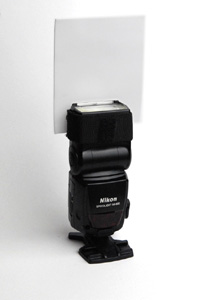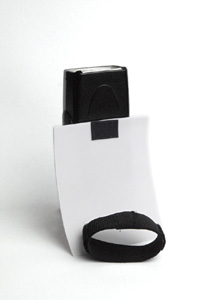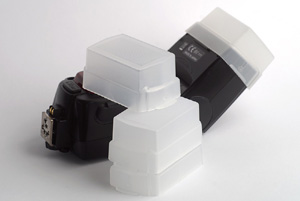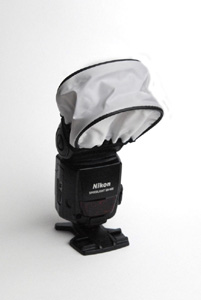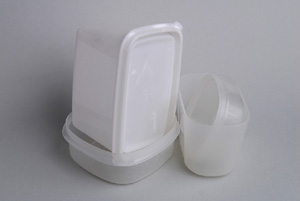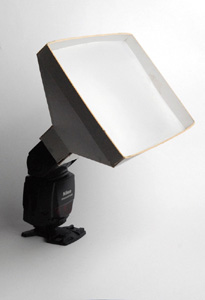Flash modifiers: diffusers
This article is about different small flash diffusers, definitely the most common light modifiers.
By diffusing or spreading the light, you get a softer look to your pictures and not least: soft shadows. The hard and harsh shadows of a direct flash is a definite no-no unless you aim for exactly that: unforgivably hard and bright light and black shadows with sharp edges. In most other cases you want to completely loose or at least soften the shadows and you want a light that treats your subject nicely rather than reveal all its flaws.
A rule of thumb is: the larger the diffuser, the softer the light. Softboxes and umbrellas are the ultimate diffusers, but we will concentrate on the smaller types here.
Bouncing
The simplest diffuser setup is a ceiling or a wall. Tipping the flash head and using any large surface can work wonders. Mounting a business card vertically behind it with a rubber band around the flash head can add some fill light to the otherwise potentially flat, bounced light. Simple and effective. The flash will bounce off walls and ceilings and the business card will supply some direct, and lightly diffused fill light.Nikon's SB800 has this feature built-in. if you pull out the wideangle diffuser that hides in the head of the flash, you will see that a small white reference card follows along. Push the diffuser back into the head and you have your business card reflector. If you want something similar for any flash, and don't have a business card, a small piece of adhesive velcro and a piece of white cardboard or foam with velcro tacked on it can do the trick.
Click-on diffusers
The most common diffuser nowadays fits over the flash head and covers the whole front of the flash with a little distance. Nikon's SB800 flash comes with such a ready made diffuser, which clicks right on to the flash, but you will have to supply your own for most other flashes.If you watch a bunch of professional photographers at a press conference or a similar venue, you will notice that many use a direct flash with an opaque diffuser over it. This will spread and soften the light a bit, and if the flash is kept over the camera, the shadows will mostly disappear behind the subjects.
Luckily there are a bunch of great diffusers to buy out there, and diffusers are amongst the easiest and cheapest DIY-projects you can make for a flash.
The factory-made ones range from simple, rectangular plastic cups like the one for the SB800 over soft fabric or inflatable constructions to complex and large gizmos that consist of many parts with hinges, plates, lenses, cones and tubes.
Simple opaque diffusers similar to the SB800 one can be bought from Nikon, Sto-Fen or in places like Precision Photo or DealExtreme. The latter two have diffusers for most flashes at very reasonable prices. I ordered several from DealExtreme and they delivered quickly and cheaply.
You can also scavenge your kitchen closets and drawers or keep a watch out in the grocery store. Lots of white and opaque plastic containers for food will make perfect diffusers with a little modding.
One of the most easily accessible and simple diffusers is a disposable plastic or styrofoam cup. Many will fit right over your flash with no or little tweaking. Once you find one that fits, just press it flat a bit a squeeze it down over the flash head. Point the flash up or directly at the target, and you will get light, which is a lot softer than from the direct flash.
In a pinch you can also drape an opaque or white plastic bag or a piece of white paper over the flash. Secure it with a rubber band or tape. While the effect is somewhat difficult to control or keep uniform, it's still better than the unbecoming direct flash and its hard shadows.
When using a diffuser you have to take into account that it will weaken the light. Most diffusers take an f-stop or two, but if you use TTL-measuring - like Nikon's CLS - you usually won't have to worry about that. The camera will adjust the flash accordingly. If you shoot manually, remember to open the aperture a bit or to increase the power of the flash to compensate.
No big art
Using a diffuser is not a big art as you can see. Some work on flashes with tilt-and-swivel heads and require you to point the flash head upwards. Others will diffuse the direct flashlight, others again will do both.Experiment with diffusers and see what works for you.
